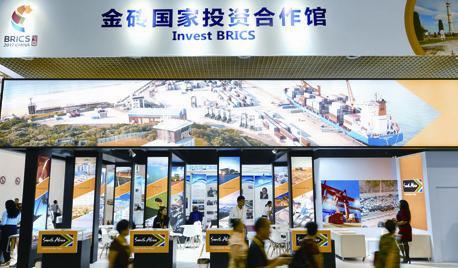Pooling Strengths
2019-11-05ByJiangShixue
By Jiang Shixue

When Jim ONeill, then Chairman of Goldman Sachs Asset Management, published the report Building Better Global Economic BRICs in 2001, he pointed out that the GDP of Brazil, Russia, India and China accounted for 23.3 percent of the world total and that the weight of the four countries would continue to expand over the next decade, raising important issues about the impact of their fi scal and monetary policies on the world economy. In line with these prospects, world policymaking forums should be reorganized and in particular, the Group of Seven (G7) should be adjusted to incorporate BRIC representatives.
Five years after the report came out, the foreign ministers of the four countries met in New York in September 2006 on the sidelines of the General Debate of the UN General Assembly, in a prelude to a series of high-level meetings. A summit meeting was held in Yekaterinburg, Russia, on June 16, 2009, and then with the inclusion of South Africa in 2011, the BRICS cooperation with its current fi ve member states was launched.
Bearing fruit
The BRICS countries account for 26 percent of the worlds land area, 42 percent of the worlds population, nearly a quarter of the worlds economy, and more than 10 percent of the worlds total foreign trade and investment. In addition, they account for well over 10 percent of the worlds voting power in the World Bank and the International Monetary Fund, which all together demonstrates the huge impact of the BRICS cooperation on the world.
Remarkable achievements have been made over the past years. The leaders of the five countries hold a summit once a year and informal meetings on other occasions for dialogue and consultation on major international issues of common interest. In addition, government departments within the group have held numerous meetings on how to cooperate further. Amid rising uncertainties in the world, such dialogue and consultation are conducive to promoting pragmatic cooperation.
The New Development Bank (NDB), which was founded by the BRICS countries and officially opened on July 21, 2015, has financed 35 projects totaling $9.3 billion. On August 17, 2017, the NDB launched its Africa Regional Center in Johannesburg. The bank will reportedly approve at least $32 billion in loans by 2021, along with bond issuance in more countries.
Critical issues
The prospects for BRICS cooperation are promising; however, the five nations should take several issues into consideration.
A number of priority areas need to be identified. During the First BRICS Summit, a joint statement containing only 15 articles was issued. But in recent years, joint statements and declarations issued at the end of leadersmeetings usually contain 100 articles, covering almost every aspect of international and national affairs.
The expansion of cooperation areas is, of course, to be congratulated and encouraged, as the determination of the BRICS countries to strengthen cooperation continues to grow. At the same time, they must decide on priorities to avoid the possible fragmentation of the BRICS cooperation.
It should be noted that BRICS has yet to create a charter, and there is no legally binding mechanism, no permanent secretariat and not even a clear purpose for cooperation.
Along with identifying priorities, the progress and implementation of various projects should be monitored to minimize the discrepancies between top-level designs completed at the leaders meetings and actual results.
The BRICS mechanism should be moderately institutionalized to increase the effectiveness of cooperation. Establishing a permanent secretariat, as a first step toward becoming institutionalized, is necessary to coordinate different views and monitor the implementation of projects. A permanent secretariat can also handle administrative affairs that are closely related to the functioning of BRICS, avoiding the predicament where the rotating presidency has the most input and say.
As its international prestige continues to grow, BRICS may attract other emerging economies, especially since its member states have always adhered to the principle of openness and inclusiveness and are willing to strengthen cooperation with them. Its very conceivable that a number of like-minded economies will be invited. Since the Xiamen Summit in 2017, the cooperation has adopted the BRICS Plus initiative, which invites leaders of relevant countries as guests to join the discussions.
There are 11 emerging economies within the Group of 20, including the BRICS countries and excluding the European Union, the G7 countries and Australia. BRICS could consider reaching out to the other six emerging economies.

Hence, members need to integrate innovation capabilities and initiate more key projects like the BRICS Institute of Future Networks. The five countries should set up a BRICS chip research institute as well, aiming to make breakthroughs in chip development and manufacturing.
While formulating or revising international rules guiding cooperation in science and technology, the fi ve nations should also strengthen consultation and communication with other countries. Some current international rules are not necessarily neutral and may even be unfavorable to emerging economies or developing countries, while rules have yet to be established in certain areas. BRICS countries should communicate more with other emerging economies and take the initiative to voice their views.
At the same time, the group needs to properly handle the relationship between bilateral and multilateral approaches. While they complement each other, the real BRICS cooperation should be the integration of the scientifi c and technological strength of all five countries or collaboration involving all of them.
